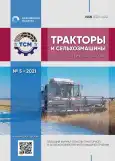Method for determining the parameters of the front loader electromechanical transmission
- 作者: Gorelov V.A.1, Kositsyn B.B.2, Stadukhin A.A.2, Chudakov O.I.2
-
隶属关系:
- Chuvash State University named after Ilya N. Ulyanov
- Bauman Moscow State Technical University
- 期: 卷 88, 编号 5 (2021)
- 页面: 38-45
- 栏目: Theory, designing, testing
- URL: https://bakhtiniada.ru/0321-4443/article/view/105667
- DOI: https://doi.org/10.31992/0321-4443-2021-5-38-45
- ID: 105667
如何引用文章
全文:
详细
A method for calculating the traction motor of a hybrid transmission of a front-end loader is proposed. It is indicated that these vehicles are characterized by a mode of operation with multiple accelerations and decelerations, as well as alternating operations with high and low required traction force. An electromechanical transmission scheme is proposed. This scheme can be effectively used in such conditions.
The proposed method uses the concept of the magnitude of the range of an electric motor, which can be used to select a specific electric motor that provides the required mobility of the vehicle. For a front loader with a lifting capacity of 3500 kg, a maximum speed of 40 km / h and a maximum specific thrust of 1, the main parameters of the traction motor were determined. However, for the transmission with one fixed gear ratio (EMT1), an electric motor with an excessively high power was obtained. Therefore, the determination of the characteristics of the electric motor for an electromechanical transmission with two fixed gear ratios (EMT2) was carried out. In the process of calculating this transmission, a significantly lower required engine power was obtained.
The article provides an approximate assessment of the energy efficiency of EMT1 and EMT2 transmissions. A method to determine the efficiency of an electric motor depending on its operating mode (on the current angular speed of the shaft and torque) was used. It was determined that the EMT2 transmission has the best efficiency of the electric motor both during bulldozing operation and when driving at maximum speed.
The general conclusion is that it is most rational to use a transmission with two fixed gear ratios. As a further direction of research, the use of computer simulation for evaluating the energy efficiency of a loader in a loading-unloading cycle is highlighted.
作者简介
V. Gorelov
Chuvash State University named after Ilya N. Ulyanov
Email: gvas@mail.ru
Dsc in Engineering
俄罗斯联邦, CheboksaryB. Kositsyn
Bauman Moscow State Technical University
Email: ant.m9@yandex.ru
PhD in Engineering
俄罗斯联邦, MoscowA. Stadukhin
Bauman Moscow State Technical University
Email: ant.m9@yandex.ru
PhD in Engineering
俄罗斯联邦, MoscowO. Chudakov
Bauman Moscow State Technical University
编辑信件的主要联系方式.
Email: ant.m9@yandex.ru
PhD in Engineering
俄罗斯联邦, Moscow参考
- Lukashuk O.A., Komissarov A.P., Letnev K.Yu. Mashiny dlya razrabotki gruntov. Proyektirovaniye i raschet: uchebnoye posobiye [Soil excavation machinery. Design and calculation: tutorial]. Yekaterinburg: Izd-vo Ural. un-ta Publ., 2018. 128 p.
- Filla R. Alternative System Solutions for Wheel Loaders and OtherConstruction Equipment // 1st CTI Forum Al-ternative, Electric andHybrid Drive Trains. Berlin, Germany, 2008.
- Pugin K.G., Burgonutdinov A.M. Mashiny dlya stroitel’stva, remonta i soderzhaniya avtomobil’nykh dorog. CH. 1. Dorozhn·yye katki i odnokovshov·yye pogruzchiki: ucheb. posobiye [Machinery for the construction, repair and maintenance of highways. Part 1. Road rollers and single-bucket loaders: textbook]. Perm’: Izd-vo Perm. nats. issled. poli-tekhn. un-ta Publ., 2011. 172 p.
- Gottschalk M., Jacobs G. and Kramer A. Test Method for Evaluating the Energy Efficiency of Wheel Loaders // ATZ offhighway worldwide. 2018, № 1, pp. 44–49. doi: 10.1007/s41321-018-0008-0
- Belonogov L.B., Ozerov A.V., Grishkevich A.S., Yankovskiy L.V. Odnokovshov·yye pogruzchiki: ucheb.-metod. Posobiye [Single-bucket loaders: training manual]. Perm’: Izd-vo Perm. nats. issled. politekhn. un-ta Publ., 2015. 155 p.
- Padalkin B.V., Ivanenkov V.V., Kositsyn B.B., Stadukhin A.A., Balkovskiy K.S. Method for assessing the effectiveness of the use of electromechanical transmissions of vehicles at the design stage. Izvestiya MGTU «MAMI». 2020. No 2 (44), pp. 58−67 (in Russ.). doi: 10.31992/2074-0530-2020-44-2-58-68
- Uebel K., Raduenz H., Krus. P., and Negri V. Design Optimisation Strategies for a Hydraulic Hybrid Wheel Loader // Proceedings of the BATH/ASME 2018 Symposium on Fluid Power and Motion Control. Bath, UK. September 12–14, 2018. V001T01A001. ASME. doi: 10.1115/FPMC2018-8802
- Stein G., Froberg A., Martinsson J., Brattberg B., Filla R. and Unnebdck J. Fuel efficiency in construction equipment – optimize the machine as one system // AVL International Commercial Powertrain Conference, 2013. doi: 10.13140/RG.2.1.2031.4089
补充文件












